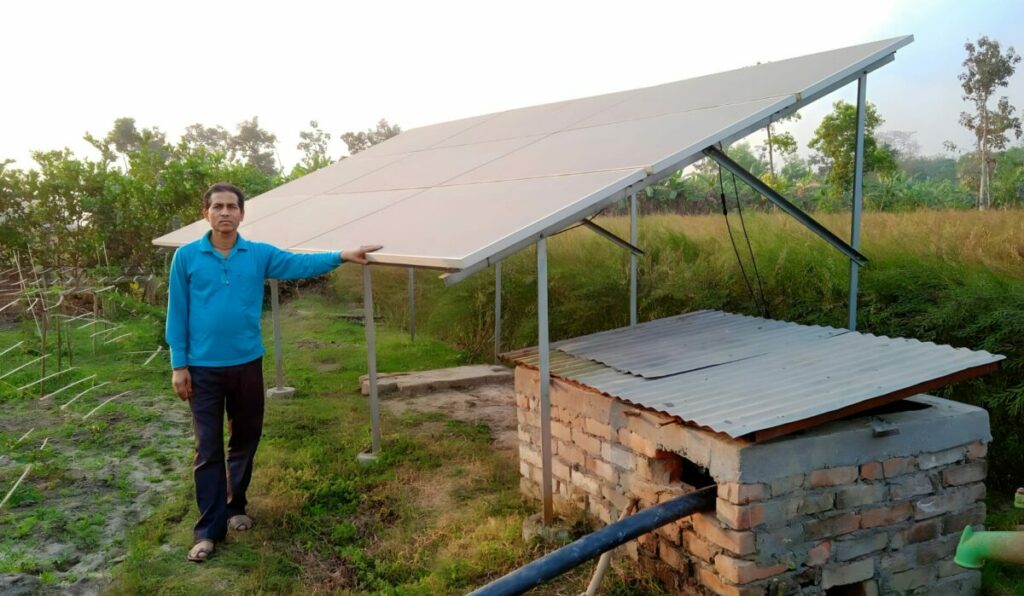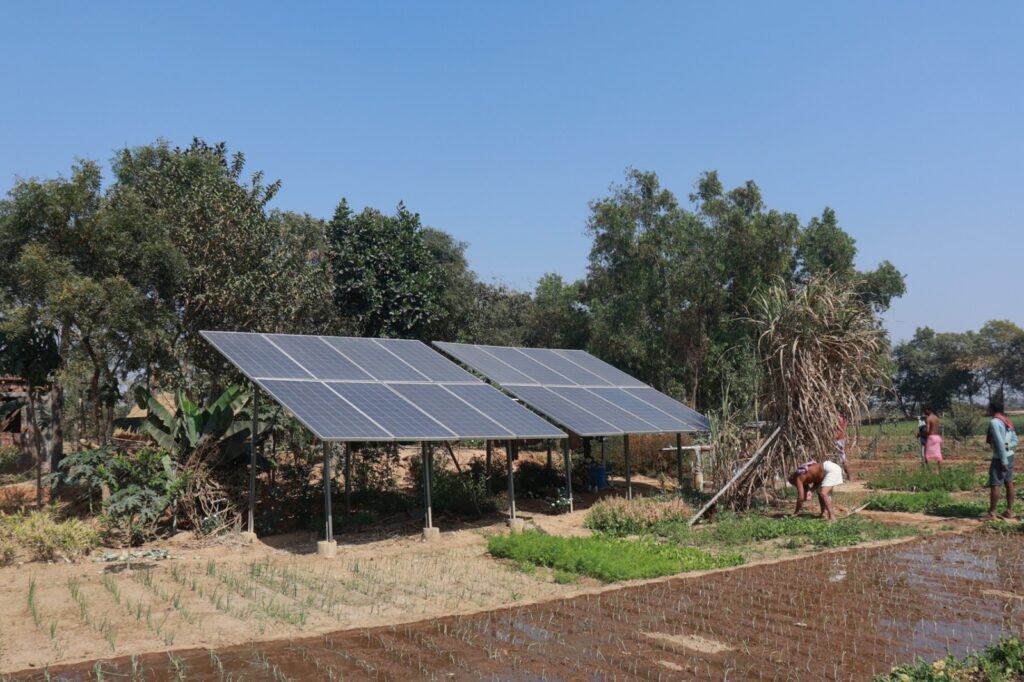SwitchON Foundation
Our foundation works on issues of global importance and the local issues of poor and marginalised farmers in rural and Indigenous communities. We are dedicated to strengthening the nexus of energy, water and agriculture in India by starting innovative projects and incubating successful ventures in renewable energy access, agrarian and allied livelihoods, skilling, the environment and climate change.
Distributed renewable energy (DRE) has been our initial area of work, where we enable farmers’ access to DRE and create the right conditions for a just transition. Our projects include installing solar water pumps for the communities, catalysing the use of sustainable technology ensuring financial viability, increasing farm productivity, implementing rainwater harvesting and drip irrigation technologies. The programs also include skill development for youth, enhanced access to clean, secure, affordable, sustainable energy. The idea is to bring innovative models such as solar villages to strengthen efforts for sustainable energy infrastructure in India.
Given the important role of energy in economic development, the Indian government has budgeted USD 12 billion for renewable energy projects in 2023. The heavy domestic reliance on fossil fuels is expected to continue nevertheless and these may fuel over 60% of installed generative capacity even in 2030. Energy inequity also persists in India, such that rural households in northern and eastern states are supplied less than 20 hours a day of electricity off the grid despite their national and global contributions.
The eastern states of Bihar, Jharkhand and West Bengal report an installed renewable energy capacity of 7800 MW, amongst the lowest of all states in India, escalating the problem of surges in power demand force, compelling people to purchase electricity at significantly higher rates. For instance, in Odisha, the current peak power demand is estimated at 5200–5400 MW though the state only generates around 4800 MW.
Fortunately, a positive outlook prevails, as seen in West Bengal’s global commitments and goal to produce 20% of its electricity from renewable sources in seven years, proving India’s potential in the adoption of renewable energy.
Addressing the issues of renewable energy in eastern India, our own work focuses on making energy infrastructure and supply accessible to last-mile communities while ensuring that the process aligns with their emerging needs. Energy and water are crucial to sustainable agriculture which most people in rural areas depend on, keeping in view the direct interconnection between the three, we developed the EEWA program – Empowering Energy, Water and Agriculture – a unique triangulation of the three aspects whose synergy we maintain throughout our project implementation to ensure an enduring effect.
DRE can help meet the needs of marginalised communities if it meets their energy demand. In order to catalyse the use of DRE technology, we help raise awareness and link farmers to financial schemes/subsidies to access renewable energy. For a lasting uptake, the farmers (especially youth & women) are trained in technology operation and maintenance. Groundwater depletion is mitigated by raising awareness in various water restoration practices such as microirrigation. Concomitantly, through Farmer Producer Groups model we help capacitate farmers to collectivise and enhance their incomes through resources and necessary support. Altogether, the EEWA program is designed to make an effective network to provide farmers with end-to-end solutions to address their most pressing issues.
An innovative financial model to improve the income generation capacity of marginalised farmers is the First Loss Default Guarantee or the Guarantee Fund, which enables security for clean energy access by the financial institutions by protecting them from any potential losses incurred by end-user non-repayment of loans. By offering them a partial risk cover, the Guarantee Fund can increase bank financing for the uptake of solar water pumps or other DRE products, with the help of which farmers have been able to reduce their high expenses on diesel and electricity. Together with a steady supply of water for irrigation, they have seen higher productivity across the cropping seasons, and higher profits in other farm activities. This has also been proven to help give farmers the security to experiment with a diversity of crops, opening more avenues for income generation.

The extreme heat in 2020 prompted Nilima Jana to begin sourcing for an irrigation system to help manage her agricultural activities. By replacing diesel-powered and the use of household electricity with DRE, she reduced her monthly electric bill and expenses. While earlier she could only cultivate potatoes and paddy, but after having a 2HP AC submersible solar pump installed, she could grow a variety of cash crops, seasonal vegetables and fruit, especially lemons and cashewnuts, which she currently cultivates on 1.3 acres of land. Ms Jana independently handles her solar water pump and plans to install another. She is inspiring the other women in her village to switch to DRE to meet their irrigation needs. This demonstrates how the EEWA program has assisted farmers in rural areas in accessing DRE as a sustainable solution for more income opportunities. By alleviating their concerns of access to water, it offers them the security to start new ventures as well, as they become part of a just transition and contribute to the overall goal of reducing our ecological footprint.
The projects implemented so far have helped promote climate-smart agrarian technologies such as solar water pumps and create awareness about microirrigation system installation and access to schemes and loans. To date we have ensured 1,000 farmers reliable access to irrigation, and 30 women farmers access to direct bank financing. We have facilitated a total of 2,800 training sessions on DRE since 2008, as well as workshops for rural youth to help create a cadre of local solar pump technicians by engaging with agencies and technical partners including the Agriculture Skill Council of India, the Deen Dayal Upadhyay Grameen Kaushalya Yojana, and the National Institute of Solar Energy. We also collaborate with state and local government agencies to facilitate the adoption and uptake of climate-smart agriculture and conduct evidence-based studies on the feasibility and impact of DRE solutions.
There is a low awareness among rural farmers on renewable energy and the financial models available to meet their energy demands. Along with this, lack of know-how on DRE solutions by farmers are some of the key challenges we face. This is the reason for why an end-to-end solution, from awareness to access, is crucial to the adoption of DRE technology. The challenges can be mitigated by strengthening the network to engage stakeholders to facilitate the easy adoption of DRE by farmers.
Future interventions for us will focus on scaling the current programs of awareness building, installing DRE technology, and reaching out to more farmers (especially women) in selected districts. Our future plans include DRE incorporation at various stages of the farmers’ livelihood and value chains in agriculture, fisheries, textiles, horticulture, and millets. Effective engagement with training institutes and agencies will help ensure the training and capacity building of farmers. It will also help develop youth trainers, ensuring the sustainability of our projects. As farmers are mobilised and encouraged to adopt DRE technology in existing local value chains, opening up more avenues for income generation and opportunities for entrepreneurship in a warming world. To help catalyse this, financial schemes and models will be made available to farmers, and efforts to collectivise them into producer groups will magnify the benefits they receive as a result of access to DRE technology in rural India.



















